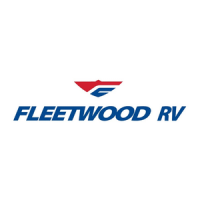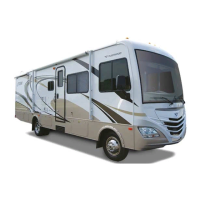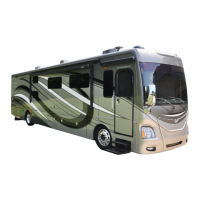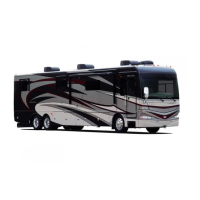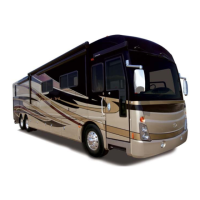Living With Your Motor Home
Moisture in the RV can stem from a variety of
sources such as spills, leaks, overflows, condensa-
tion, damp or standing water and human activity
such as showering or cooking. Good maintenance
practices are essential in the effort to prevent or
reduce mold growth.
What the RV Owner Can Do
The RV owner can take positive steps to reduce
the occurrence of mold growth in the RV and
thereby minimize any possible adverse effects
they may be caused by mold.
These steps may include, but are not limited to,
the following:
• Before bringing items into the RV check for
signs of mold. Potted plants (root and soil),
furnishings, or stored clothing and bedding
materials may also contain mold spores.
• Regular vacuuming and cleaning will help
reduce levels of settled mold spores.
Additionally, detergent solutions and most
tile cleaners are effective in controlling
mold growth on surfaces.
• Keep the humidity in the RV below 40%.
Ventilate kitchens and bathrooms by open-
ing windows, using exhaust fans, or run-
ning the air conditioning to remove excess
moisture in the air and to facilitate evapo-
ration of water from wet surfaces. In gen-
eral, windows or doors throughout the RV
should be opened periodically to ventilate
the RV.
• Promptly clean up spills, condensation, and
other sources of moisture. Thoroughly dry
any wet surfaces or material. Do not let
water pool or stand in or under your RV.
• Inspect for leaks on a regular basis. Look
for discolorations or wet spots. Repair any
leaks promptly. Inspect condensation pans
(refrigeration and air conditioners) for
mold growth. Take notice of musty odors
and any visible signs of mold growth.
Other actions the RV owner can take to prevent
moisture issues include the following:
• Do NOT use unvented Propane, kerosene,
or other unvented combustion heaters;
• Do NOT cover or close off the floor regis-
ters; (if equipped)
• Check your cooling equipment filter on a
monthly basis;
• Use the air conditioner or a dehumidifier
during humid months, particularly during
the summer in hot, humid climates;
• Use exhaust fans in kitchen and bathrooms
to remove excess moisture;
• Clean the bathroom with mold-killing
products
For more information about mold, and what you
can do to reduce moisture and mold growth in
your RV, please refer to the following websites
and literature;
1. U.S. Environmental Protection Agency.
Mold Remediation in Schools and
Commercial Buildings 2001.
http://www.epa.gov/iaq/molds/moldremediation.html
2. U.S. Environmental Protection Agency.
A Brief Guide to Mold, Moisture, and Your
Home, 2002.
http://www.epa.gov/iaq/molds/moldquide.html
The particle board, hardwood plywood, or pan-
eling used in your motor home are made with
urea-formaldehyde resin. The companies that
supply us with these materials have asked that
we tell you about urea-formaldehyde with the
statements on this page.
Ventilation is important for making the interior
of your motor home comfortable. Please read
the section about ventilation and prolonged
occupancy in the Living With Your Motor
Home chapter in this Owner’s Manual.
We provide you consumer information as detailed
by the National Fire Protection Association
(NFPA) and the American National Standards
Institute (ANSI). The information and warnings
found on these pages may also be found in other
chapters of this Owner’s Manual. Please see the
Propane System and Appliances chapters for
other safety and operating information.
06-4
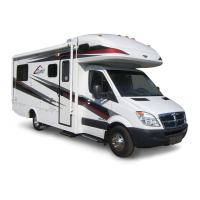
